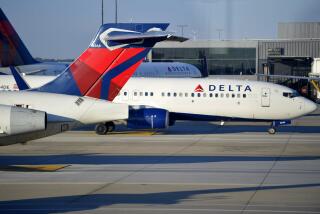Flying Scared : Flight Crews Increasingly Want to Know: Has This Plane Been Threatened?
NEW YORK â Fear of flying has grown since the bombing of Pan American World Airwaysâ Flight 103 on Dec. 21, especially among flight crews, and interviews indicate that many of those who fly for a living are dejected and uneasy.
Along with the fear and unhappiness, there is intensified debate over whether airlines should tell crews and passengers about such sabotage threats and, if so, how much.
Just last week, a group of jittery United Airlines flight attendants took matters into their own hands. They were responding to a threat phoned to the U.S. Embassy in Oslo saying that a U.S. airliner flying between New York and Los Angeles would be sabotaged Jan. 3.
Complaining that United did not give them sufficient information about the threat, seven members of the cabin crew refused to fly a Los Angeles-bound flight on that day. As a consequence, the flight had to be canceled, but the threat turned out to be unfounded.
Although no other such cases have been reported, flight attendants generally have been more cautious--and more fearful--than in the past. For instance, some say they that while they used to be somewhat careless with their hand-carried baggage, now they never let it out of their sight in airports.
As might be expected, the psychological state of Pan Am flight attendants, especially those at the London base, from which the 13 attendants on Pan Am 103 came, has been the most affected. As a result, Pan Am has offered counseling to attendants who feel that they need it and has allowed attendants who get cold feet at the last minute to walk away from a flight.
And some passengers are becoming militant.
A few days before the ill-fated Pan Am flight, Alan M. Dershowitz, a well-known Harvard University law professor, was on a Pan Am shuttle destined for New York from Boston. After the plane began to taxi for takeoff, it was surrounded by police, who boarded it and escorted a group of men off the aircraft. It turned out that one was a former Mexican presidential candidate against whom there had been a threat.
Once the group had left the plane, Dershowitz wrote later in a newspaper column, Pan Am planned to continue the flight with the remaining passengers. However, when Dershowitz learned the reason for the groupâs leaving the plane, he felt that the threat against the Mexican was in effect the same as one against himself, since they were riding on the same plane.
So he used the cellular telephone he was carrying to call police, who ordered the plane back to the gate and allowed passengers who wanted to get off to do so.
There seems to be no doubt that nervousness about flying is at a peak.
In the New York City suburb of Harrison, for example, the school district has canceled all school-sponsored trips overseas by student groups until further notice. The school boardâs ruling means that a planned student trip to France next month will not occur. Among the 259 passengers on Pan Am 103 was a 1985 graduate of Harrison High School.
âPeople are anxious,â said Homer Boynton, head of security for American Airlines. âEven I am anxious when I get on a plane.â
But there is a variety of opinions on whether--or how much--flight crews and passengers should be told about threats of sabotage.
Some pilot groups, flight attendant unions and passenger organizations side with the United cabin crew. They complain that they are not being kept properly informed and insist that they should be told of all threats--even those that police and airline managers do not take seriously.
âCreates a Lot of Stressâ
But frequently such groups concede that if flight crews, and especially the public, are informed about every episode there would be unnecessary and unwarranted fear and concern and that the nationâs airline flight system could be brought to a standstill. They maintain that each case should be evaluated by airline and security experts, with crews and the public being informed only in clearly dangerous situations.
âIt takes experts and numerous pieces of intelligence to determine a danger,â said Luke Bradley, chairman of the Air Line Pilots Assn.âs flight security committee and a pilot for Pan Am.
Flight crew unions generally agree that serious threats must be sifted from the phony ones and that crews are in no position to do so. âSomebody else has to cull that out,â said Tom Lambert, president of the Pan Am chapter of the Flight Engineers International Assn. âIf every threat of a bomb were treated in the same manner without determining if it was a hoax, the planes would stop.â
Carla Winkler, president of Continental Airlinesâ Union of Flight Attendants, said she has âmixed feelingsâ about being informed about threats.
âIt creates a lot of stress to have to worry about that aspect on a trip,â she said. On the other hand, she added, âit makes flight crews more aware and more conscious and makes them a bit more alert. We could live with procedures where we would not have to know about every threat so long as we know there is a competent investigating team looking into the legitimacy of the threat.â
Airline Passengers of America, a consumer advocacy group, wants passengers to be warned when the government believes that the danger is sufficient to notify its agencies and embassies.
âIn the case of the Pan Am threat, the government should not have discriminated between who was told and who was not,â said David Jeffrey, the groupâs manager of member services and public affairs. âThe general public should have been told.â
Most airlines will not discuss any specific aspects of security. But a few that did gave some clues as to what they believe passengers and flight crews should be told.
Evaluating Threats
American Airlines sometimes keeps its crews in the dark about threats it does not take seriously. Boynton notes that in the last decade there were 15,000 bomb threats against U.S. airlines and that virtually none were serious.
âMost of these threats,â he said, âcome from people with aberrant behavior, demented persons or people who are going to be late for their planes and want to delay it--which does not work. If you give credence to every one of these threats and if you hold up every plane, it would be hard to run an airline.â
The procedures airlines and government agencies use to evaluate threats have grown more sophisticated in recent years.
âIn the past there used to a knee-jerk response to any and every threat. Every one was considered serious, without discrimination,â said Richard Lally, vice president-security of the Air Transport Assn., the airline industry trade group. âEach case was handled in the same way even though it was recognized that some were no more (serious) than when kids call the local tobacco store to ask if it has Prince Albert in a can.â
But in the last few years, he added, a system has been adopted in which certain criteria are applied to evaluate threats. âThe hoaxes are screened out so there can be an adequate response to the serious threats.â
Said Boynton: âWe have certain indicators. . . . If these indicators are not in the threat, then we declare it an indefinite threat, and we do not tell the crew.â
Pan Am, according to a spokeswoman for its flight attendants union, the Independent Union of Flight Attendants, also has different levels of alert. âThe lowest is the nut call,â she said. âAnd it becomes more serious from there.â
The airlines, of course, will not disclose the nature of the way they judge the seriousness of threats.
When there is a serious-sounding threat while an airliner is aloft, Boynton said, American will not tell its passengers about it until the plane has landed. âWe donât want to have a bunch of hysterical people at 31,000 feet,â he said.
Delta Airlines takes a different approach. It levels with crew and passengers whenever there is any threat of sabotage (though it also waits for a plane to land before making any announcement). âWe have to treat everything as if it is a real thing,â said Delta spokesman William Berry.
âWe have found that we need to keep everybody in the loop to keep the rumor mill down,â he added.
Publicity Not Helpful
Delta says that in the two-week period since the Pan Am bombing the number of bomb threats it receives has doubled. Even a fast search, Berry said, takes two to three hours, and a bomb threat, causing the delay of one flight, reverberates throughout Deltaâs nationwide route system for the rest of the day.
Publicity is not helpful, most airline officials believe. Media attention, said Berry, breeds additional threats. Recently, he recalled, there was a bomb scare on one of Deltaâs planes. The airline was not able to persuade a local television station not to report the incident, and within two hours after the broadcast there were two more threatening calls.
While some flight labor organizations say that crews do not need to know about every hoax bomb threat, others feel that their members are not being told enough. The Eastern Airline pilots local, for example, is feuding with the carrier over what constitutes a direct threat against a specific flight and about which it must be informed. Such threats are labeled âpositive target identifications,â as opposed to what is simply a general threat.
The union maintains that the airline does not believe that a threat that includes the number of a plane or the number of a flight is enough to constitute a PTI. The airline, according to the union, says such information is readily available to anyone looking at the tail of a plane or at an airport monitor screen and that crews do not have to be informed.
An Eastern spokesman, however, said the airlineâs procedures are âmuch more refinedâ than that and show âa far greater concern for the public safety.â He would not give details of Easternâs procedures in the face of bomb threats, however.
Pan Amâs flight attendants have an informal agreement with the airline that crews be told about sabotage threats, a flight attendants union spokeswoman said. But it is not a contractual agreement, and the union is urging the government to make divulging such information to crews mandatory.
More to Read
Sign up for The Wild
Weâll help you find the best places to hike, bike and run, as well as the perfect silent spots for meditation and yoga.
You may occasionally receive promotional content from the Los Angeles Times.






